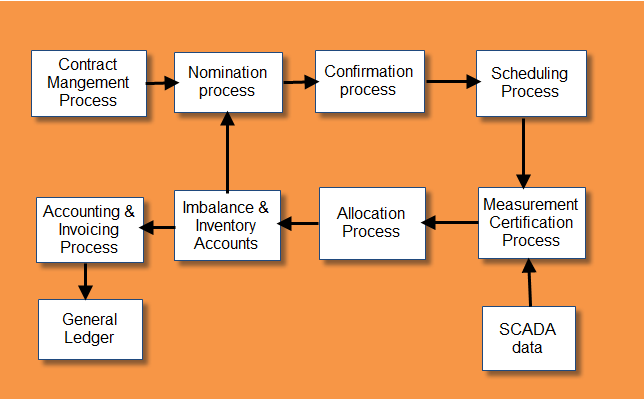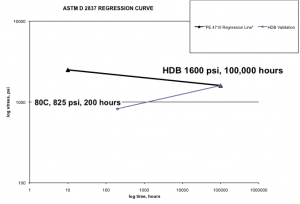December 2012, Vol. 239 No. 12
Features
Transportation Management Software Solutions For LDCs

It is a common misperception that gas industry local distribution companies (LDCs) only deliver to — and manage contracts and billing accounts for — residential gas consumers. In fact, many LDCs also have large-scale transportation agreements in place with industrial or commercial consumers.
This article outlines some of the challenges that industrial and commercial consumers can create for LDCs, and how LDCs can better manage their commercial transportation agreements using an industry-proven pipeline transportation management solution rather than relying on legacy systems or spreadsheets.
Challenge. LDCs will frequently provide transportation services to shippers (marketers or agents) who buy gas from producers or interconnected pipelines (either intrastate or interstate) and deliver it to large and medium-sized consumers or end-users in their distribution network. These shippers must buy transportation services from the LDC for the transportation of the gas from receipt point on the LDC’s distribution network to the individual delivery point on the LDC’s distribution network.
Depending on the size of the LDC, the amount of physical sub-networks and the number of market areas associated within that network may vary greatly. Similarly, the number of transportation agreements managed by the LDC will vary. However, in general, the number of commercial or industrial accounts will be much smaller than the number of accounts the LDC has for residential delivery.
For example, an LDC with 150,000 residential customers might have fewer than 60 transportation agreements. In this case, the LDC will likely have a computer billing system that works well managing the contracts for the 150,000 residential customers, but poorly or not at all when it comes to managing the 60 transportation contracts. This is because of the much more complicated formula and fee management requirements associated with those contracts.
In the 1990s, many LDCs initially addressed the challenge of the deregulated utility industry with a multiservice-oriented business model. The approach combined traditional services with the expanded opportunities of specialized or non-traditional services in a comprehensive, integrated solution based on custom applications or complex, in-house solutions. However, over time, undesirable side effects have caught up with many of those legacy applications and home-grown solutions resulting in:
1) Limited scalability, often with poor performance and dependability as requirements grew.
2) Limited flexibility due to legacy code, making upgrades difficult and/or too expensive.
3) Mismatches with changing business processes, resulting in redundant data.
4) Patches and fixes that keep the system running without recognizing new workflows.
5) Outdated technology, resulting in anxiety for management and IT teams worried about system crashes.
6) A dead-end system with little or no outside support, technical documentation, product roadmaps, upgrades etc.
7) A limited and shrinking internal knowledge pool as people who know how to use the product and/or who developed the system leave the business or retire.
A robust, viable solution for managing commercial and industrial transportation agreements can be a mission-critical part of the day-to-day operations of any larger LDC’s gas transportation business. As a result, many LDCs have started to review current risks from their legacy systems in detail, and have begun to evaluate migration paths to an industry-proven product such as PipelineTransporter from Energy Solutions International.
Solution. The first step for an LDC in this situation is to perform a gap analysis between its existing solution – as implemented and used by the LDC – and an available commercial solution like PipelineTransporter that has been designed to manage large-scale commercial transportation agreements. Next, they should ensure that the vendor of any solution is well-established, has excellent references, and can demonstrate industry expertise as well as offering a product that is industry-proven. The subsequent gap analysis document would allow the LDC to make an informed decision based on the following items: 1) redundancy of data and fields; 2) suggested changes to business processes; 3) required customizations and configuration changes; 4) identification and evaluation of existing third-party interfaces; and 5) required hardware and infrastructure.
Based on the results of the gap analysis, the LDC should be able to find an off-the-shelf software product that assists the LDC by managing third-party access of gas shipped on their facilities. The gas business cycle for the LDC managing transportation agreements should be integrated into the product, from request for shipping of gas to invoicing for the shipment of gas. The typical gas business cycle is illustrated in Figure 1 and each process step is fully described in the “Key Capabilities Table” in Figure 2.
In technology as in life, a “one size fits all” approach to solving most challenges does not work. However, through a thoughtfully architected solution the same common product core can be used across a broad category of customers to support varying needs. As a result of this approach, the LDC should be looking to partner with a third-party product vendor to enhance the product’s core modules and provide highly tailored, yet packaged, software functionality that meets their needs as well as the needs of their transportation customers.
Key Capabilities. Some of the core functionality that the LDC should focus on when looking for a standard product to manage their gas transportation agreements is listed in Figure 2, the “Key Capabilities Table.”

Figure 2: Typical Core Functionality recommended for LDCs
By selecting a commercially developed, product-based gas management solution to manage their industrial and commercial gas transportation agreements, the LDC would gain a highly tailored, yet standardized off-the-shelf product that meets its needs today and for the foreseeable future. Upgrading to the latest release of a product is becoming easier with each new release, minimizing disruption to the production environment.
At the same time, the product vendor continues to enhance the product for managing gas transportation agreements including adding more features and capabilities that are both market-driven and product-driven. The LDC has the added benefit of having the option to join forums or committees that would assist the vendor on developing future product roadmaps.
The LDC that implements a commercial, product-based solution should expect the following to be part of the benefits realized after some time:
1) Product: The solution they implement is based on a core product that has roadmaps and is supported by a larger reputable company understanding their business process.
2) Synchronization: The core product could potentially be the repository for company information; hence data is only updated in one place and distributed to other systems accordingly.
3) Existing Infrastructure: The LDC already has a gas management system for managing its residential customers based around a specific database and operating platform. By selecting a vendor product that works on similar databases and platforms, the IT team at the LDC will have fewer interfaces to support and lower risk.
4) Cleanup of Data: During the implementation process of the new product the LDC should use the opportunity to clean up any outdated and redundant data found in the original legacy database.
5) Streamlining Business Processes: The LDC should use the implementation of the new product to review all of its business processes to attempt to make them more effective and efficient while at the same time not interrupting normal day-to-day operation.
6) Less Paper. The Web client in the new product should allow the LDC to enable access to more detailed invoice data online for the customers to collect themselves, rather than sending multiple pages with every invoice.
Technology has developed significantly over the past 10 years and while many vendors still provide their solutions based on highly customized implementations, there are vendors in the market that have industry-proven core products that can deliver a very capable, “fit-for-purpose” solution at a reasonable cost. In most cases, the benefits of such a solution to help manage the complexity of the commercial and industrial transportation requirements now far outweigh the growing risks of staying on a legacy solution or rebuilding it with customized development.
Author
Lars Larsson is product manager for Energy Solutions International. He holds a Bachelor of Engineering degree from University of Sheffield in the UK and a Master’s in Business Administration from University of Durham in the UK. He is a registered Eur-Ing through FEANI. He has worked for 19 years with ESI.





Comments